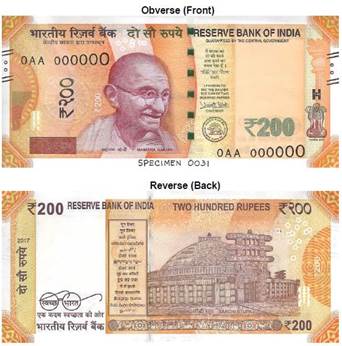
Disclaimer: Copyright infringement not intended.
Context
- Several Aam Aadmi Party (AAP) leaders have asked the government to put pictures of Goddess Lakshmi and Lord Ganesh on currency notes in order to bring “prosperity” to the country.
Who decides what Indian bank notes and coins are supposed to look like
- Changes in the design and form of bank notes and coins are decided by the Reserve Bank of India (RBI) and the central government.
- Any change in design of a currency note has to be approved by the RBI’s Central Board and the central government.
- Changes in the design of coins are the prerogative of the central government.
What role does the RBI play in issuing notes?
- RBI internally works out a design, which is put before the RBI’s Central Board.
- Section 22 of The Reserve Bank of India Act, 1934, gives RBI the “sole right” to issue banknotes in India.
- Section 25 states that the design, form, and material of bank notes shall be such as may be approved by the Central Government after consideration of the recommendations made by the RBI’s Central Board.
- The RBI’s Department of Currency Management has the responsibility of administering the core function of currency management.
- The Department addresses policy and operational issues relating to the “designing of banknotes; forecasting demand for notes and coins; ensuring smooth distribution of banknotes and coins throughout the country and retrieval of unfit notes and uncurrent coins from circulation; ensuring the integrity of bank notes”, etc.
- If the design of a currency note has to change, the Department works on the design and submits it to RBI, which recommends it to the central government. The government gives the final approval.

Who decides on the minting of coins?
- The Coinage Act, 2011 gives the central government the power to design and mint coins in various denominations. In the case of coins, the role of the RBI is limited to the distribution of coins that are supplied by the central government.
- The government decides on the quantity of coins to be minted on the basis of indents received from the RBI on a yearly basis.
- Coins are minted in four mints owned by the Government of India in Mumbai, Hyderabad, Kolkata and Noida.
How does RBI’s currency management work?
- The Reserve Bank, in consultation with the central Government and other stakeholders, estimates the quantity of banknotes that are likely to be needed denomination-wise in a year, and places indents with the various currency printing presses for their supply.
- In terms of its clean note policy, the RBI provides good-quality banknotes to the public. Notes that are received back from circulation are examined, after which those fit for circulation are reissued, while the soiled and mutilated notes are destroyed.
- Two of India’s currency note printing presses (in Nasik; and Dewas) are owned by the Government of India two others (in Mysore and Salboni) are owned by the RBI through its wholly owned subsidiary, Bharatiya Reserve Bank Note Mudran Ltd (BRBNML).
- Banknotes in denominations of Rs 10, Rs 20, Rs 50, Rs 100, Rs 200, Rs 500, and Rs 2,000 are currently being issued.
- Notes of Rs 2 and Rs 5 are no longer issued; however, older notes of these denominations, if still in circulation, continue to be legal tender. Re 1 notes, if in circulation, are also legal tender.
What are the types of notes issued so far?
* Ashoka Pillar Banknotes: The first banknote issued in independent India was the Re 1 note issued in 1949. While retaining the existing design, the new banknotes replaced the portrait of King George with the symbol of the Lion Capital of the Ashoka Pillar at Sarnath in the watermark window.
* Mahatma Gandhi (MG) Series, 1996: All the banknotes of this series bear the portrait of Mahatma Gandhi on the obverse (front) side, in place of the symbol of Lion Capital of Ashoka Pillar, which was moved to the left, next to the watermark window. These banknotes contain both the Mahatma Gandhi watermark as well as Mahatma Gandhi’s portrait.
* Mahatma Gandhi series, 2005: The “MG series 2005” notes were issued in denominations of Rs 10, Rs 20, Rs 50, Rs 100, Rs 500, and Rs 1,000. They contain some additional/ new security features as compared to the 1996 MG series. The Rs 500 and Rs 1,000 notes of this series were withdrawn w.e.f. the midnight of November 8, 2016.
* Mahatma Gandhi (New) Series, 2016: The “MGNS” notes highlight the cultural heritage and scientific achievements of the country. Being of reduced dimensions, these notes are more wallet friendly, and are expected to incur less wear and tear. The colour scheme is sharp and vivid.
The first banknote from the new series — of Rs 2,000 denomination — was introduced in 2016, with the theme of Mangalyaan. Subsequently, banknotes in this series in denominations of Rs 500, Rs 200, Rs 100, Rs 50, Rs 20, and Rs 10 were introduced.
https://indianexpress.com/article/explained/explained-politics/aap-wants-lakshmi-ganesh-on-currency-who-designs-rupee-notes-and-how-8231728/




